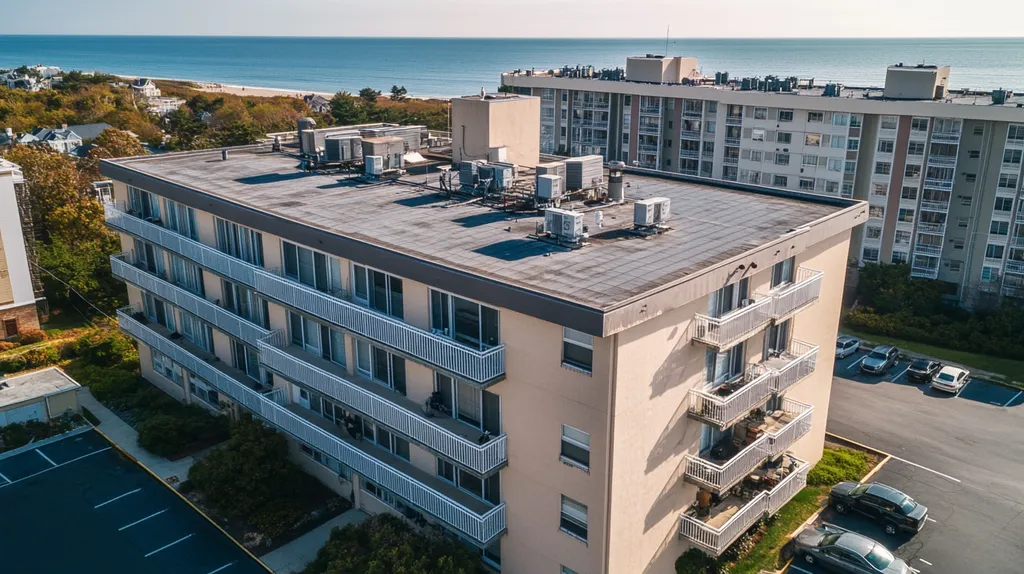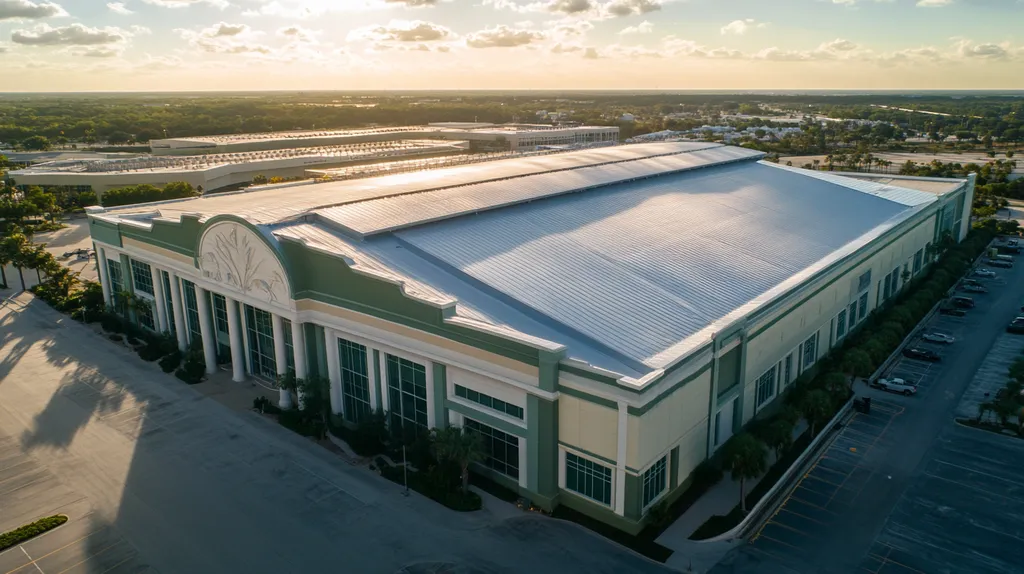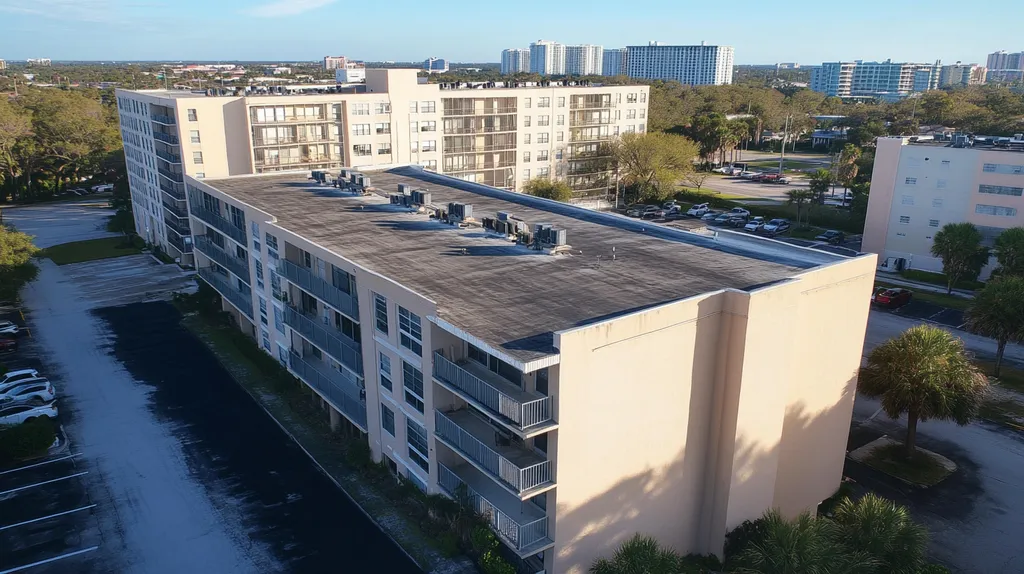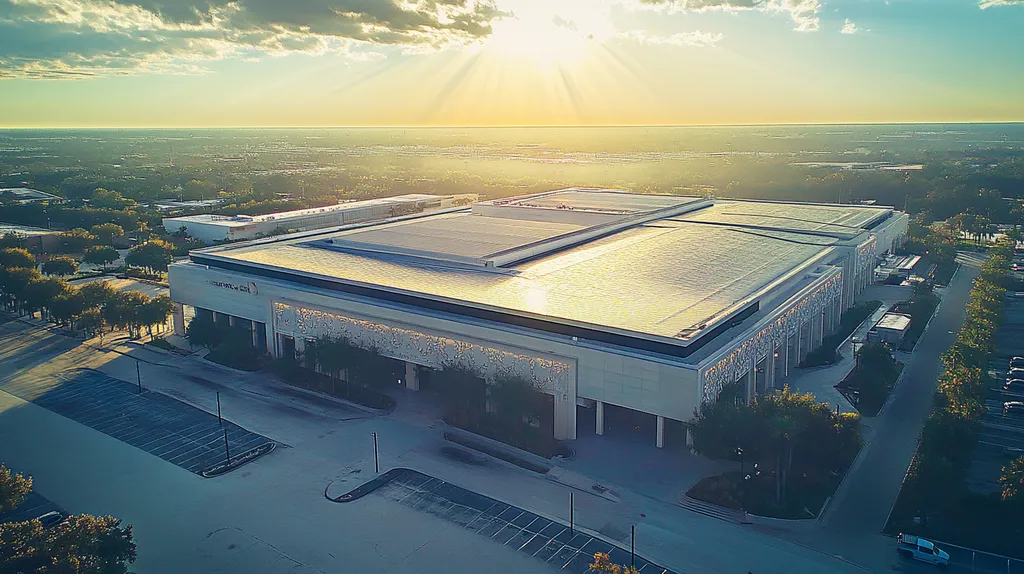Commercial roofing professionals face a stark reality: over 30% of a building’s energy costs stem directly from inadequate or improperly installed insulation, costing businesses billions annually in wasted expenses.
Yet widespread misconceptions about commercial roof insulation continue to plague the industry, leading to premature system failures and skyrocketing operational costs.
From moisture damage to structural deterioration, the consequences of getting insulation wrong extend far beyond mere energy inefficiency.
This comprehensive analysis exposes the truth about insulation’s critical role in commercial roofing, examining common myths, practical implications, and evidence-based solutions that every facility manager needs to understand.
SECTION 1: COMMON MISCONCEPTIONS
Misunderstandings about insulation in commercial roofing can have serious financial repercussions for property owners and facility managers. These misconceptions not only risk increased energy expenses—potentially rising by 30% due to improper insulation—but can also jeopardize the durability and performance of the roof itself. Being aware of these common myths is essential for making smart, informed choices about roofing systems.
Excessive Insulation is Always Better
There’s a popular assumption that simply increasing insulation levels will result in higher energy efficiency. While adequate insulation is crucial for regulating indoor temperatures, too much can create serious problems. Excessive insulation traps moisture within the roofing system, which can lead to mold growth and deterioration of roofing materials.
This accumulation of moisture diminishes the roof’s performance, potentially resulting in greater maintenance expenses. Furthermore, local building codes often specify maximum insulation levels that should not be exceeded. It is imperative for property owners to collaborate with experienced roofing professionals to determine the ideal insulation level tailored to their building type and geographical context.
Striking the right balance is essential; achieving optimal energy efficiency without compromising the structural integrity of the roofing system is paramount.
Reusing Wet Insulation is Safe
A particularly hazardous misconception is the notion that wet insulation can be reused without safety concerns. Insulation is vital for maintaining thermal performance, and when soaked, it can lose as much as 50% of its effectiveness. This reduction not only impacts energy efficiency but can also turn wet insulation into a breeding ground for mold and mildew, endangering the health of building occupants.
While the idea of saving costs by reusing wet insulation may seem attractive, it often leads to far greater expenses from necessary remediation and building repairs. Roofing experts assert that any insulation that has been compromised by moisture should be replaced immediately. By prioritizing dry, effective insulation, building owners can better ensure both the safety of their tenants and the energy efficiency of their commercial roofs.
Disregarding moisture issues is a risky gamble that could ultimately harm finances and tenant satisfaction.
Anyone Can Install Commercial Roof Insulation
Many property owners mistakenly believe that installing insulation is a straightforward task that can be managed by anyone. This misconception can lead to significant long-term issues. Poor installation can cause air leaks, diminishing energy efficiency and driving up heating and cooling costs significantly.
Professional installation is not just a formality; it ensures compliance with building codes and manufacturer warranties, maximizing overall insulation performance. Inexperienced installers may neglect critical aspects, such as proper sealing and unique requirements associated with different insulation types.
Moreover, improper installation can void warranties and even compromise the entire roofing system, leading to pricey repairs or replacements down the line. Engaging qualified contractors with industry knowledge ensures insulation is installed correctly, enhancing the functionality and lifespan of the roofing system.
In summary, partnering with experienced professionals is an investment that can save both time and money, ensuring insulation works effectively and efficiently.
SECTION 2: PRACTICAL IMPLICATIONS
Proper insulation is essential for the efficiency and durability of commercial roofing systems. Failing to install and maintain insulation correctly can lead to serious consequences, such as moisture damage and rising energy costs. For instance, roofs lacking sufficient insulation typically experience heightened heating and cooling expenses, costing businesses significantly over time. Recognizing these practical implications is crucial for property owners and facility managers who are committed to maximizing their building’s performance.
Moisture Trapping and Structural Damage
Inadequate insulation can create a setup where moisture becomes trapped within the roofing system. This moist environment promotes mold and mildew growth, which can deteriorate roofing materials and prompt costly structural issues over time. For example, prolonged moisture exposure can weaken roof decking, raising the risk of leaks that can cascade into more extensive damage.
Moreover, this excess moisture diminishes the insulation’s ability to perform effectively, causing energy inefficiencies that inflate utility bills unnecessarily. If a facility is compromised due to moisture-related damage, it may face a complete roof replacement rather than simple repairs, drastically increasing expenses.
Regular inspections are vital for catching signs of moisture damage early. Property owners should emphasize preventive measures, such as ensuring adequate ventilation, to combat moisture trapping. By adopting these strategies, businesses can avoid astonishing repair costs and extend the lifespan of their roofs.
Ultimately, grasping the dynamics of moisture is critical to prolonging the life of commercial roofing systems. Proactive efforts can shield facilities from the financial burdens associated with moisture-related challenges.
Impact on Roofing System Adhesives
The quality of insulation directly influences the effectiveness of roofing system adhesives. When insulation is poor, temperature fluctuations can weaken adhesive bonds, leading to issues such as membrane separation and potential roofing failures.
For instance, adhesive breakdown can result in water infiltration, triggering further complications, including the deterioration of insulation and other structural components. Such failures often require immediate attention, leading to interruptions in business operations and unexpected costs.
Facility managers must recognize the significant interplay between insulation quality and adhesive performance. Opting for high-quality, compatible adhesives designed to work efficiently with insulation materials can enhance the overall durability of the roof. Regular assessments of both insulation and adhesives are crucial to maintaining peak roofing performance.
In essence, ensuring the compatibility of materials and installation standards is vital for preserving the integrity of commercial roofing systems.
Condensation Issues in Insulated Roofs
Condensation can manifest as a serious concern in insulated roofs, particularly when insulation is improperly installed. This phenomenon occurs when warm, moist air rises and encounters cooler surfaces, leading to the formation of water. If not addressed, this moisture can compromise insulation performance, benefitting neither efficiency nor structural stability.
For example, a single breach in the roofing system can permit indoor humidity to contact cooler surfaces, creating extensive condensation issues. The aftermath can involve significant mold growth, leading to costly remediation processes.
Property owners should implement effective ventilation strategies to mitigate condensation risks. Utilizing vapor barriers and ensuring sufficient airflow can manage moisture levels effectively within the roofing system. An educated approach to insulation placement is crucial for preventing these concerns.
In summary, taking proactive steps to tackle condensation can safeguard commercial roofs against severe damage and maintain operational efficiency.
SECTION 3: COST OF MISINFORMATION
The stakes surrounding roofing insulation are incredibly high, and misinformation can lead to dire financial consequences. Shockingly, the U.S. Department of Energy reports that over 30% of a building’s energy loss stems from inadequate insulation. This doesn’t just elevate operational costs; it can severely compromise roof performance and lead to premature failures. Recognizing the real costs of misinformation is crucial for property owners and facility managers who are committed to maintaining their investments.
Financial Consequences of Incorrect Insulation
Incorrect insulation choices can impose substantial financial burdens on property owners. When insulation is poorly selected, energy consumption skyrockets, resulting in dramatically increased electricity and heating bills. A building lacking adequate insulation may face energy costs surging by 20% or more each year.
Interestingly, the initial lower costs of improper insulation can be deceiving. Over time, the higher energy expenses can far outstrip any upfront savings. To ensure long-term financial viability, engaging insulation experts during the material selection process is essential.
Additionally, insufficient insulation creates maintenance headaches. A failure to perform its intended functions often leads to frequent repairs and operational disruptions. All of these factors contribute to escalating budgets and can significantly hinder overall financial health.
In summary, making informed insulation choices is vital to preserving the financial integrity of commercial properties.
Premature Roof Replacement Costs
Misinformation about insulation can accelerate roof replacements, wreaking havoc on a property owner’s budget. Quality insulation serves as a vital protective layer that extends the lifespan of roofing systems. Without proper insulation, moisture accumulates, leading to structural damage and necessitating premature replacements.
For example, a commercial property could incur costs exceeding $100,000 for a roof replacement that could have been delayed through proper insulation strategies. Such unplanned expenses disrupt business operations and complicate financial planning efforts.
Moreover, replacing a roof before its intended lifespan represents a significant waste of resources and financial investments. Effective insulation not only prolongs roof life but also fosters environmental sustainability by reducing waste.
Investing in accurate insulation information prevents substantial replacement costs and enhances overall property value.
Energy Efficiency and Operational Expenses
The consequences of misinformation regarding insulation also extend to energy efficiency and operational costs. Well-implemented insulation directly correlates with reduced energy usage, leading to lower operational expenses. Unfortunately, many property owners fall prey to pervasive myths about insulation effectiveness, leaving them with inefficient systems.
A properly insulated building can save thousands of dollars annually by optimizing energy consumption. In fact, integrating high-quality insulation can lead to reductions in heating and cooling costs by up to 50%. Such savings can be redirected toward other essential operational needs or reinvested to improve the property.
In addition to financial savings, energy-efficient operations contribute to a smaller environmental footprint. As sustainability becomes increasingly prioritized, ensuring the right insulation not only enhances building performance but also provides a competitive edge.
In conclusion, prioritizing accurate insulation information is vital for enhancing energy efficiency, reducing operational expenses, and promoting a sustainable future.
SECTION 4: REALITY CHECK
As pressure mounts for property owners and facility managers to maximize roof performance, the crucial role of insulation is often underestimated. Research indicates that improper insulation can trigger energy losses of up to 30%, substantially boosting operational costs. To truly enhance roof efficiency and ensure lasting building integrity, it’s vital to understand insulation requirements, the importance of vapor barriers, and the most effective insulation types available.
Measuring Required Insulation Levels
Establishing the right insulation levels for commercial roofs is critical for optimal performance. The recommended R-value, which reflects insulation effectiveness, varies with climate and building type. For instance, a minimum R-value of 30 is typically necessary in colder regions to effectively combat heat loss.
Conducting a comprehensive energy audit can aid facility managers in assessing current insulation levels. This valuable data helps determine whether upgrades are essential to conform to energy codes or industry best practices.
Additionally, regular evaluations must include checks for moisture infiltration, a factor that can significantly reduce insulation efficiency. Overlooking these steps can result in costly repairs and shorten the roof’s lifespan.
The urgency is clear: actively measuring insulation levels can preempt substantial future expenses and energy waste.
Importance of Vapor Barriers
The integration of vapor barriers is paramount for optimizing roof insulation effectiveness. These barriers shield insulation from moisture, a major culprit in thermal performance compromise. Without effective vapor management, moisture can lead to mold proliferation and material deterioration.
In humid climates, pairing insulation with vapor barriers is essential to ensure longevity. Proper placement is critical; barriers should typically be installed on the warm side of the insulation.
Neglecting vapor barrier installation can drastically reduce energy efficiency, causing heating and cooling costs to spike. This reality underscores the point that vapor barriers are not just optional enhancements; they are integral to an efficient roofing system.
In summary, the conjunction of vapor barriers and insulation is crucial for maintaining thermal performance and safeguarding the entire roof structure.
Suitable Insulation Types for Commercial Roofs
Making informed choices about insulation types is vital for maximizing overall roof performance and efficiency. From rigid foam boards to spray foam, each option presents unique benefits. Rigid foam, for example, delivers outstanding R-values alongside moisture resistance, making it an exceedingly popular selection.
Another strong contender is mineral wool, which provides fire resistance and soundproofing in addition to its thermal insulation properties. The right insulating material must also adhere to environmental regulations and building codes, which can differ widely.
Facility managers should collaborate with knowledgeable professionals to assess which insulation type best fits their specific needs and objectives. This informed approach safeguards compliance while enhancing energy efficiency.
In conclusion, selecting the appropriate insulation type, coupled with strategic installation, can lead to significant energy cost reductions and improved overall building performance.
SECTION 5: EVIDENCE-BASED ALTERNATIVES
The efficiency of commercial roofing systems is fundamentally tied to the insulation materials and installation techniques chosen. With soaring energy costs, improper insulation can lead to staggering financial losses. As highlighted by the U.S. Department of Energy, up to 30% of heating and cooling energy may be wasted due to insufficient insulation. Therefore, making informed decisions regarding insulation selection and installation is crucial for improving roof performance and sustainability.
Choosing the Right Insulation Materials
Choosing insulation materials for commercial roofs is not a one-size-fits-all process. Property owners typically weigh options such as fiberglass, foam board, and spray polyurethane foam, each with unique characteristics affecting thermal performance, moisture resistance, and lifespan. For instance, foam board insulation provides excellent thermal resistance, which can lower energy expenses significantly over time.
In addition, the roof’s specific environment should dictate the material choice. For example, in areas facing extreme temperatures or high humidity, materials that provide greater durability, like closed-cell spray foam, are preferable due to their water resistance.
Fire safety is another critical consideration. Opting for materials that comply with local building codes ensures safety and adherence to regulations. Some options, like PIR (Polyisocyanurate) insulation, offer superior fire resistance, enhancing safety in commercial settings.
Ultimately, informed decisions about insulation materials can lead to substantial immediate and long-term savings, making it essential for property owners to select energy-efficient options that fit their operational needs and environmental conditions.
Proper Installation Techniques
Even the highest-rated insulation materials can fall short without proper installation. Correct installation is key to maximizing the benefits of insulation. Manufacturers typically provide specific guidelines that must be strictly followed during this process.
For instance, ensuring a continuous insulation layer is essential to eliminate thermal bridging, which can seriously hinder a roof’s efficiency. Any gaps or compressions in insulation can lead to unnecessary energy costs and reduced comfort levels within the building.
Moisture management is also a vital consideration during installation. Proper use of vapor barriers is crucial to prevent condensation, which leads to mold and mildew, particularly in highly humid environments.
Conducting regular inspections during and after installation helps identify potential issues early, allowing for timely interventions. Hiring trained professionals familiar with industry standards can help avoid costly mistakes and ensure optimal roof performance.
Environmental Benefits of Correct Insulation
Correct insulation plays an essential role in promoting sustainability in commercial roofing. High-quality insulation reduces energy consumption, leading to fewer carbon emissions. The Environmental Protection Agency states that improving a building’s energy efficiency can significantly reduce greenhouse gas emissions, likened to removing multiple cars from the road.
Additionally, by minimizing energy requirements, adequately insulated roofs can extend the life of HVAC systems, reducing maintenance costs and the environmental impact associated with frequent system replacements.
Moreover, energy-efficient roofs often qualify for local government and utility incentives, which can help offset initial insulation expenses and enhance return on investment.
In summary, careful selection of insulation, along with proper installation and awareness of environmental benefits, is vital for effective commercial roofing. These considerations are not just about compliance; they pave the way for sustainable roofing solutions that meet today’s environmental goals.
SECTION 6: TEST AND VERIFY
Neglecting the performance of insulation in commercial roofing can spell disaster for property owners and facility managers. Research indicates that more than 30% of energy costs may stem from insufficient or compromised insulation. To safeguard investments, it is crucial to prioritize testing and verification, ensuring that insulation remains effective and efficient over time. This section will delve into the significance of assessing insulation performance, conducting regular inspections, and verifying the integrity and safety of roofing systems.
Insulation Performance Over Time
Insulation doesn’t keep its effectiveness forever. Various factors such as moisture intrusion, temperature fluctuations, and physical damage can diminish its performance over time. Regular assessments are essential for preventing costly repairs and ensuring energy efficiency.
It is advisable to evaluate insulation performance at least once a year, especially in regions where weather extremes are common. High-quality insulation can significantly reduce heating and cooling costs, enhancing the overall performance of the building.
Using advanced technologies like infrared imaging allows facility managers to identify problematic areas where insulation is failing without invasive interventions. By pinpointing heat loss or gain, quick corrective actions can be taken to prevent further issues.
Moreover, investing in robust insulation monitoring systems offers real-time data on insulation effectiveness. This proactive strategy helps ensure that roofs continue to perform optimally throughout their lifecycle.
Conducting Regular Roof Inspections
Regular roof inspections are vital to catch issues early before they evolve into larger problems. A visual inspection should take place semi-annually, while a thorough evaluation should be conducted at least once a year.
During these inspections, it’s critical to watch for signs of wear, including pitting in the insulation or moisture issues that threaten its efficiency. Documenting these findings is important for establishing strategic maintenance plans.
Employing drones or specialized inspection tools can enhance the efficiency of these evaluations, enabling property owners to detect insulation issues that are hard to identify through traditional methods.
Furthermore, involving seasoned roofing professionals ensures inspections are comprehensive and yield actionable insights, contributing significantly to the longevity and effectiveness of the roofing system.
Verifying Insulation Integrity and Safety
Verifying the integrity of insulation goes beyond ensuring performance; it also addresses safety concerns. Compromised insulation can create risks such as fire hazards or mold growth, making continuous assessment critical.
Utilizing moisture meters and thermal imaging technology can help reveal hidden issues that standard inspections may overlook. Detecting these vulnerabilities early is essential for protecting both the structure and the people within it.
Compliance with local building codes and standards is also an integral part of this verification process. Ensuring that insulation materials and installation practices meet regulations minimizes health and safety risks.
Establishing a maintenance and verification plan, complete with specific benchmarks and timelines, can streamline this process. Regular updates and training for facility teams enhance awareness and responsiveness regarding insulation safety and performance.
The Bottom Line
With over $4 billion wasted annually on energy losses from improper commercial roof insulation, the stakes couldn’t be higher for property owners and facility managers.
The evidence is clear: proper insulation selection, professional installation, and regular verification form the foundation of an efficient, long-lasting commercial roofing system.
Industry data shows that buildings with optimized insulation systems can reduce energy costs by up to 30% while extending roof lifespans by 5-10 years.
As environmental regulations tighten and energy costs continue to rise, implementing evidence-based insulation practices isn’t just smart business – it’s essential for survival in today’s competitive commercial real estate market.
The time for addressing insulation deficiencies is now, before mounting costs and structural damage force even more expensive solutions.
FREQUENTLY ASKED QUESTIONS
Q. Is excessive insulation beneficial for my commercial roof?
A. Excessive insulation may trap moisture within your roofing system, leading to mold and structural damage. While insulation is crucial for energy efficiency, more isn’t always better. Collaborate with professionals to determine the ideal insulation level for your roof, ensuring its durability and performance.
Q. How does poor insulation affect my industrial roof?
A. Insufficient insulation can trap moisture, causing structural damage and escalating repair costs. It can lead to spikes in energy expenses, resulting in significantly increased operational costs for your industrial facility. Regular assessments are crucial to maintaining insulation effectiveness and prolonging the lifespan of your roof.
Q. Can wet insulation be reused in my commercial roofing?
A. Reusing wet insulation jeopardizes thermal performance and health safety due to mold growth. Compromised insulation can lose significant effectiveness and lead to costly repairs. Making the decision to replace rather than reuse wet insulation protects both your building occupants and the efficiency of your roofing system.
Q. Why are vapor barriers important for my commercial roof?
A. Vapor barriers prevent moisture penetration that can compromise insulation effectiveness. Without these barriers, insulation can become a breeding ground for mold, which may endanger both your roof’s integrity and occupant health. Proper installation is crucial for maintaining thermal performance and safeguarding your entire roofing system.
Q. How does incorrect insulation impact operational costs?
A. Incorrect insulation can inflate energy costs significantly, potentially increasing bills by 20% or more. Poorly insulated roofs often lead to frequent repairs and operational disruptions, creating additional financial strain. Engaging insulation experts ensures proper material selection and reduces long-term costs associated with energy inefficiency.
Q. Why should I perform regular roof inspections?
A. Regular inspections are essential for catching issues early, preventing costly repairs later. These evaluations help identify signs of wear, moisture infiltration, or insulation degradation that may compromise efficiency and safety. Frequent checks enable timely maintenance, extending the life of your commercial roofing system.
Q. What insulation types are best for commercial roofs?
A. The best insulation types vary based on building needs, climate, and performance requirements. Rigid foam boards provide excellent thermal resistance, while spray foam offers durability and moisture protection. Collaborating with roofing professionals helps determine the ideal material for your specific roofing conditions and goals.










